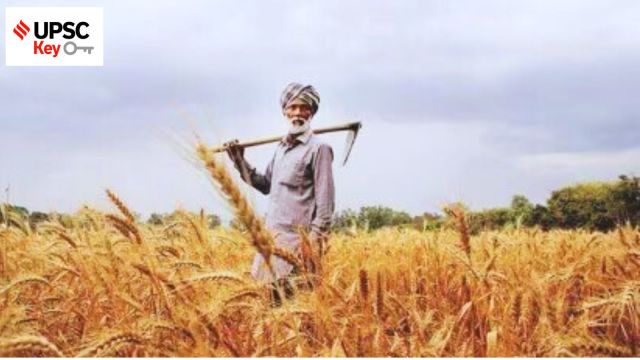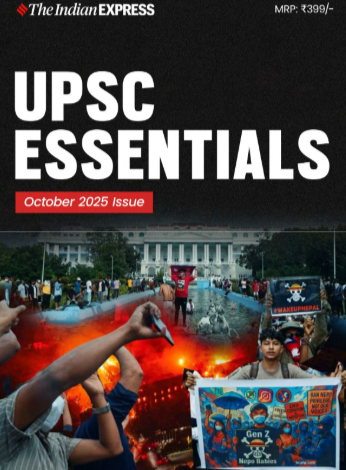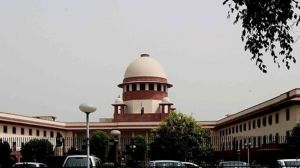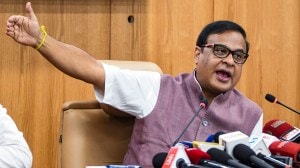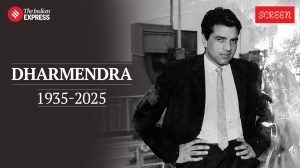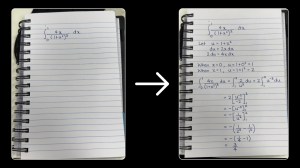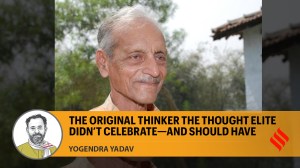🚨 The Indian Express UPSC Essentials brings to you the May edition of its monthly magazine. Click Here to read. Share your views and suggestions in the comment box or at manas.srivastava@indianexpress.com🚨
Front Page
UPSC Syllabus:
Preliminary Examination: Economic and Social Development-Sustainable Development, Poverty, Inclusion, Demographics, Social Sector Initiatives, etc.
Mains Examination: GS-II, GS-III: Government Policies & Interventions, Issues related to direct and indirect farm subsidies and minimum support prices.
What’s the ongoing story- Bihar, Uttar Pradesh and Rajasthan lead the chart of 1.16 lakh farmers who have voluntarily given up the benefits of the annual Rs 6,000 Pradhan Mantri Kisan Samman Nidhi (PM-Kisan) scheme across the country from June 2023 to May 2024, according to data available with the Ministry of Agriculture & Farmers Welfare.
Prerequisites:
— What is PM Kisan Samman Nidhi (PM-Kisan) Yojana?
( Thought Process: When was the PM-Kisan scheme launched? Is it a center-sector scheme or center-sponsored scheme? It is implemented by which ministry? etc.)
— What are the objectives of PM-Kisan scheme?
— Who is eligible for the PM-Kisan scheme?
Key takeaways:
Story continues below this ad
— Sources said the Agriculture Ministry had introduced a module in the PM-Kisan mobile app and website last year which enables farmers to voluntarily exit the scheme.
— Officials said the possible reasons for some farmers giving up the PM-Kisan benefits include: absentee landlords who may have decided against availing of the subsidy; land going to tax-paying descendants who are not eligible; change in the status of land-owners.
— The scheme was launched on February 24, 2019. The PM-Kisan is a Central Sector scheme with 100% funding from the Centre. The fund is directly transferred to the bank accounts of the beneficiaries.
— Under the PM-Kisan scheme, eligible farmer families receive Rs 6,000 per annum in three equated instalments through Direct Benefit Transfer (DBT) every four months.
Points to Ponder:
— What are the issues associated with the PM-Kisan scheme?
— How does the PM-Kisan scheme benefit the farmers?
Story continues below this ad
— What are the initiatives taken by the government to ensure the financial security of farmers?
— What measures should be taken for the growth of the Indian agriculture sector?
Post Read Question:
Explain various types of revolutions, took place in Agriculture after Independence in India. How these revolutions have helped in poverty alleviation and food security in India? (UPSC CSE 2017)
Other Important Articles Covering the same topic:
What is PM Kisan Samman Nidhi Yojana?
Explained Page
UPSC Syllabus:
Preliminary Examination: Current events of national and international importance
Story continues below this ad
Mains Examination: GS-II: Bilateral, regional and global groupings and agreements involving India and/or affecting India’s interests.
What’s the ongoing story- Around 373 million citizens across the 27 member states of the European Union are eligible to vote on June 6-9 in elections to the European Parliament, which is the only directly elected body of the EU.
Prerequisites:
— What is the European Union (EU)?
— What are the member countries of the EU?
— Know about the brief history of the EU?
Key takeaways:
— The European Parliament (EP) represents the citizens of its member states. Its primary functions include negotiating EU laws with the member state governments, which are represented by the European Council.
— The EP also approves the EU budget and votes on international agreements and enlargements of the bloc. It also has the power to approve or reject the appointment of the European Commission president — currently Germany’s Ursula von der Leyen — and the commissioners.
Story continues below this ad
— Unlike national parliaments, the EP does not have the right to propose laws but can only negotiate those proposed by the executive European Commission.
— The EP comprises 720 Members (MEPs) elected every five years. The MEPs then elect their president for a term of two and a half years.
— In 21 member states, people aged 18 and above can vote.
— Citizens living in another EU country can choose to vote for candidates either from their country of origin or from their country of residence.
— In some member states, voters can only choose closed lists that do not allow change of order for preferred candidates, while in others they can select individual candidates in a preferential system.
Story continues below this ad
— All candidates must be EU citizens. Voters may choose from individual candidates or political parties’ delegates, depending on the country. Once elected, politicians from each nation will flow into the European groups that form the Parliament, based on political orientations. Elected individuals cannot hold functions in national governments or other political bodies such as the EU Commission.
Points to Ponder:
— What is the European Council? What are the powers and functions of the European Council?
— What is the significance of Europe for India?
— What are the areas of cooperation between India and EU?
Post Read Question:
Consider the following statements: (UPSC CSE 2023)
The ‘Stability and Growth Pact’ of the European Union is a treaty that
Story continues below this ad
1. limits the levels of the budgetary deficit of the countries of the European Union
2. makes the countries of the European Union to share their infrastructure facilitie
3. enables the countries of the European Union to share their technologie
How many of the above statements are correct
(a) Only one
(b) Only two
(c) All three
(d) None
Other Important Articles Covering the same topic:
India-EU still diverge on key issues as EFTA deal goes through
Story continues below this ad
UPSC Syllabus:
Preliminary Examination: General Science
Mains Examination: GS-III: Science and Technology- Awareness in the fields of Space.
What’s the ongoing story- Amitabh Sinha writes- “Amidst all the political activity around the elections, a private space company, Agnikul Cosmos, carried out the first successful launch of its indigenously-built rocket last week, opening up a new chapter in India’s space sector.”
Prerequisites:
— What is 3D Printing and its usage?
— What is Small Satellite Launch Vehicle (SSLV)?
— What is IN-SPACe?
Key takeaways:
— “This was not the first time that an Indian private company had flown a rocket from Indian soil. In November 2022, Skyroot Aerospace, a young space start-up just like Agnikul, successfully launched a rocket which it has named Vikram..”
— “Agnibaan was powered by the world’s first 3-D printed engine, and was launched from Agnikul’s own launchpad, built at ISRO’s Sriharikota launch facility. Both Agnikul and Skyroot hope to begin launching commercial satellites on their rockets within a year.”
— “The rocket flown on Thursday will eventually have several variants, capable of carrying payloads between 30 kg and 300 kg to lower earth orbits. The Skyroot rocket, Vikram, also has a few variants, with similar capabilities. Both of these are targeting the small satellite market to cater to a rapidly growing demand for a variety of space-based applications in areas as diverse as communications, broadcasting, disaster management….These satellites are usually not meant for space exploration or scientific experiments.
— ISRO itself is developing a new rocket, called SSLV or Small Satellite Launch Vehicle, to serve this demand. SSLV, which has flown twice but only once with success, is slightly more powerful and can carry payloads up to 500 kg.
— “The uniqueness of Agnibaan lies in the fact that its semi-cryogenic engine is entirely 3-D printed…The use of 3-D printing in space hardware is not a novel idea. But no one has used an entire engine that is 3-D printed.”
— “3-D printing can increase efficiency, bring down costs, and reduce the probability of something going wrong…Agnibaan’s engine, named Agnilet, has been an entirely in-house development.”
— “The fact that Agnibaan was launched from a privately owned launch pad is a first for India…Given the prospect of a sharp rise in the number of space launches, ISRO is in the process of developing a second space port, at Kulasekarapattinam in Thoothukudi district, Tamil Nadu. It is meant to be used mainly for SSLV launches.”
Points to Ponder:
— What are the advantages and disadvantages of using 3-D printing in the space sector?
— What are the opportunities and challenges of private sector participation in space missions?
— What are the initiatives taken by the government to promote the privatisation of the space sector?
Post Read Question:
With reference to India’s satellite launch vehicles, consider the following statements: (UPSC CSE 2018)
1. PSLVs launch the satellites useful for Earth resources monitoring whereas GSLVs are designed mainly to launch communication satellites.
2. Satellites launched by PSLV appear to remain permanently fixed in the same position in the sky, as viewed from a particular location on Earth.
3. GSLV Mk III is a four-staged launch vehicle with the first and third stages using solid rocket motors; and the second and fourth stages using liquid rocket engines.
Which of the statements given above is/are correct?
(a) 1 only
(b) 2 and 3 only
(c) 1 and 2 only
(d) 3 only
Mains
Discuss India’s achievements in the field of Space Science and Technology. How the application of this technology has helped India inits socio-economic development? (UPSC CSE 2016)
Other Important Articles Covering the same topic:
Startup launches Agnibaan with world’s 1st 3D-printed engine
UPSC Syllabus:
Preliminary Examination: Indian Polity and Governance
Mains Examination: GS-II: Indian Polity
What’s the ongoing story- Over the last month and a half, 642 million voters have spoken in the largest democratic exercise in the history of the world. The counting of votes will begin at 8 am on Tuesday. Fairly clear trends are likely to emerge over the following four hours.
Prerequisites:
— What are the constitutional provisions related to the elections?
— What are Electronic Voting Machines (EVMs) and VVPAT (Voter Verified Paper Audit Trail)?
— Read about the Election Commission of India (ECI).
Key takeaways:
— Counting is carried out under the supervision and direction of the Returning Officer (RO) for each seat, in the presence of the candidates and their election agents. The RO, typically the District Magistrate of the district concerned, is nominated by the ECI.
— Assistant Returning Officers are also empowered to oversee the counting, especially where an RO is responsible for more than one constituency. The actual counting of votes in the EVMs at various tables is done by counting officials appointed by the RO, based on the anticipated number of postal ballots and the number of counting tables.
— The following are allowed to enter the counting hall: counting supervisers, counting assistants, micro-observers, ECI-authorised individuals and Observers, public servants on election duty, and candidates, election agents, and counting agents.
— The law permits the candidate to appoint as many counting agents as there are counting tables, including the table where postal ballots are counted.
— Police officers and government ministers are not classified as “public servants” in this context. No one, including the candidate, RO, or Assistant RO, is permitted to carry a mobile phone inside the counting hall. The only person who can do so is the ECI’s Observer.
— Rule 51 (“Time and place for counting of votes”) of The Conduct of Election Rules, 1961, says that the “returning officer shall, at least one week before the date, or the first of the dates, fixed for the poll, appoint the place or places where the counting of votes will be done and the date and time at which the counting will commence…”. The ECI’s Handbook for Returning Officers says: “For the sake of uniformity, the date and time of counting of votes is fixed by the Commission.”
— Two types of votes are counted: EVM votes, and votes cast through postal ballots (which are used for senior citizens, physically challenged individuals, service voters, etc). Postal ballots are counted separately from EVM votes.
— The tallying of VVPAT commences after all rounds of EVM counting are completed. This process is done sequentially, not simultaneously, for all polling stations. On average, it takes about an hour to verify the slips from each VVPAT machine.
Points to Ponder:
— What challenges are associated with ensuring free and fair elections in India?
(Thought Process: How do money and muscle power influence the elections? How do emerging technologies such as AI and deepfakes affect the election process?)
— What electoral reforms have been taken by the ECI to enhance the quality of democracy in India?
— What measures can be taken to make the election process fair?
Post Read Question:
Consider the following statements: (UPSC CSE 2021)
1. In India, there is no law restricting the candidates from contesting in one Lok Sabha election from three constituencies.
2. In 1991 Lok Sabha Election, Shri Devi Lal contested from three Lok Sabha constituencies.
3. As per the existing rules, if a candidate contests in one Lok Sabha election from many constituencies, his/her party should bear the cost of bye-elections to the constituencies vacated by him/her in the event of him/her winning in all the constituencies.
Which of the statements given above is/are correct?
(a) 1 only
(b) 2 only
(c) 1 and 3 only
(d) 2 and 3 only
Other Important Articles Covering the same topic:
What is an EVM? How does it work?
Express Network
UPSC Syllabus:
Preliminary Examination: Indian polity
Mains Examination: GS-II: Statutory, regulatory and various quasi-judicial bodies.
What’s the ongoing story- With former Supreme Court judge Arun Mishra demitting office as chairperson of the National Human Rights Commission after a three-year stint, the Centre on Monday appointed Vijaya Bharathi Sayani as acting chairperson.
Prerequisites:
— What is the National Human Rights Commission (NHRC)?
(Thought Process: When was it established, is it a statutory body or constitutional? What is the composition of NHRC?)
— What are the functions and powers of NHRC?
— Read about the Protection of Human Rights Act, 1993.
Key takeaways:
— The President, under Section 7(1) of the Protection of Human Rights Act, 1993, is pleased to authorise Smt Vijaya Bharathi Sayani, Member, National Human Rights Commission, to act as the Chairperson of the National Human Rights Commission, with effect from 02.06.2024, until the appointment of a new Chairperson in the NHRC to fill such vacancy,” a notification by the Ministry of Home Affairs stated.
— In 2019, Parliament had amended the Protection of Human Rights Act, 1993, to revise the eligibility criteria for the post of chairperson of NHRC and state human rights commissions. While only a retired Chief Justice of India could be appointed as NHRC chairperson earlier, the amended law allowed a judge of the Supreme Court to be considered for the position.
Points to Ponder:
— What are the structural and practical limitations of the NHRC in redressing the complaints of human rights violations?
— What are the major challenges faced by the NHRC?
— What reforms are necessary to strengthen the National Human Rights Commission (NHRC)?
Post Read Question:
Other than the Fundamental Rights, which of the following parts of the Constitution of India reflect/reflects the principles and provisions of the Universal Declaration of Human Rights (1948)? (UPSC CSE 2020)
1. Preamble
2. Directive Principles of State Policy
3. Fundamental Duties
Select the correct answer using the code given below:
(a) 1 and 2 only
(b) 2 only
(c) 1 and 3 only
(d) 1, 2 and 3
Other Important Articles Covering the same topic:
Institutional mechanism in India to address rights violations, says NHRC chief
The Ideas Page
UPSC Syllabus:
Preliminary Examination: Indian polity
Mains Examination: GS-II: Government policies and interventions, Role of civil services in a democracy.
What’s the ongoing story- Praveen Pardeshi writes- “India has embarked on the path towards Viksit Bharat by 2047. It’s clear what India aspires to achieve: Becoming a manufacturing hub in the global supply chain, critical exporter of value-added services and mass supplier of human skills to an ageing developed world. But the “how” seems to concern many.
Prerequisites:
— What is Mission Karmayogi?
— What is the Capacity Building Commission (CBC)?
— What is iGOT Karmayogi Bharat learning portal?
Key takeaways:
— “Improved governance and efficient and competent civil services are required for achieving India’s ambitions.”
— “ Mission Karmayogi, that is, the National Programme for Civil Services Capacity Building, to transform India’s three million civil servants into citizen-centric, future-ready and result-oriented karmayogis. As part of Mission Karmayogi, the Capacity Building Commission (CBC) was constituted in 2021 to provide policy guidance and tools to enhance the capabilities of all levels of India’s vast civil services.”
For Your Information:
— ‘Mission Karmayogi’ is a capacity-building scheme for civil servants aimed at upgrading the post-recruitment training mechanism of the officers and employees at all levels.
Points to Ponder:
— What are the advantages of the Mission Karmayogi?
— What are the obstacles in achieving the objectives of Mission Karmayogi?
— What are the recommendations of the 2nd Administrative Reforms Commission?
— What administrative reforms have been taken by the government for making governance more accessible?
Post Read Question:
What do you understand by the terms ‘governance’, ‘good governance’ and ‘ethical governance’? (UPSC CSE 2016)
Other Important Articles Covering the same topic:
What is Mission Karmayogi?
The Editorial Page
UPSC Syllabus:
Preliminary Examination: Indian economy
Mains Examination: GS-III: Agriculture and issues related to direct and indirect farm subsidies and minimum support prices.
What’s the ongoing story- Ajay Vir Jakhar writes- “As India traverses the road to Amrit Kaal, the agriculture sector’s journey will be difficult, and filled with challenges. It is not too difficult to fathom why. In this century, Indian agriculture has been grappling with how to move on from the old model. Policymakers have failed to ensure dignified livelihoods for farmers. We are confronted by a certain set of circumstances, changing which may be beyond our ability.”
Prerequisites:
— Agriculture is a subject of which constitutional list?
— What is the contribution of agriculture to India’s GDP?
Key takeaways:
— “One, the climate is changing irreversibly for the worse. We are already witnessing the beginning of erratic climatic events impacting crop production and livelihoods. Two, the World Trade Organisation will not change and we will have to live with its iniquitousness. For many years, the US has deliberately crippled the dispute-settlement mechanism…Three, the large number of small land holdings (85 per cent of total arable land) fundamentally limits the scope for primary producers to eke out a life of dignity from their profession.”
— “Four, the global priority to ensure low food prices for consumers is easiest achieved by artificially driving down farm-gate prices. This makes farming environmentally unsustainable and economically unremunerative.”
— “Five, depleting aquifers due to the insatiable demand for water for agriculture is reaching a threshold point where it won’t be economically viable to extract water for irrigation in food basket regions.”
— “The key challenge is not just to improve agricultural productivity, which is simply more output from a given level of inputs, but in ensuring that the productivity gains can be sustained and are broadly shared. That growth is inclusive.”
Points to Ponder:
— What are the challenges faced by the agricultural sector?
— What is climate-smart agriculture?
— What agricultural reforms have been taken by the government?
— What measures should be taken to ensure that agriculture sector growth is more inclusive?
(Thought Process: Read about sustainable agriculture, government initiatives related to sustainable agriculture, etc.)
Post Read Question:
Prelims
In India, which of the following can be considered as public investment in agriculture? (UPSC CSE 2020)
1. Fixing Minimum Support Price for agricultural produce of all crops
2. Computerization of Primary Agricultural Credit Societies
3. Social Capital development
4. Free electricity supply to farmers
5. Waiver of agricultural loans by the banking system
6. Setting up of cold storage facilities by the governments
Select the correct answer using the code given below:
(a) 1, 2 and 5 only
(b) 1, 3, 4 and 5 only
(c) 2, 3 and 6 only
(d) 1, 2, 3, 4, 5 and 6
Mains
Explain various types of revolutions, took place in Agriculture after Independence in India. How these revolutions have helped in poverty alleviation and food security in India? (UPSC CSE 2017)
Other Important Articles Covering the same topic:
Ashok Gulati writes: How India can minimise climate risk in agriculture
UPSC Syllabus:
Preliminary Examination: General issues on Environmental Ecology, and Climate Change – that do not require subject specialisation.
Mains Examination: GS-I, GS-II, GS-III: Important Geophysical Phenomena, Climate Change Environmental Pollution & Degradation, Government Policies & Interventions.
What’s the ongoing story- Anumita Roychowdhury Writes- “Urban plans do not factor in heat and changing climate adequately. The weakest link is lack of mandate to make policies work at ground level”
Prerequisites:
— What is an urban heat island?
— What are heatwaves?
— What are heat action plans?
Key takeaways:
— “The recent analysis of six megacities carried out by the Centre for Science and Environment (CSE) indicates growing heat stress in urban centres of the country due to rising air temperature, relative humidity and land surface temperature. Nights are not cooling down adequately any more. This intensifies thermal discomfort and increases the disease burden.”
— “Several factors are at play. The continuous expansion of the built-up area is increasing heat-trapping concrete surfaces in urban areas…”
— “The growing heat risk and urban heat island effect have massive equity impacts. The urban maps of heat hotspots overlay snugly with the maps of areas where poor people live. The poor are more vulnerable, given their underlying diseases and patterns of unprotected exposures.”
— “The Intergovernmental Panel on Climate Change warns that even if global warming is stabilised at 1.5°C, the frequency and intensity of heat extremes and duration of heat waves will keep rising; and urban growth will further amplify this impact.”
— “Climate change may be a constant. However, for resilient cities, responsive policies are needed to strengthen the coping and adaptive capacity of the urban population.”
— “Cities have begun framing heat action plans….These plans are yet to mature and acquire a legal and funding backup to have an enforceable legal mandate for heat management to reduce the overall thermal load on urban infrastructure and built structures.”
— “There are several regulatory instruments in place related to urban resource management, land use, thermal comfort and energy efficiency in built structures, that are not leveraged adequately.
These include environment impact assessment for buildings and townships, urban and regional development plans formulation and implementation (URDPFI) and urban master plans, energy conservation building codes and Eco Samhita…”
— “Planning needs to go much deeper than the immediate emergency or disaster response to specific heat episodes. This needs sustained action throughout the year to heatproof the city. Ensure land-use changes to expand the green areas and water bodies for a stronger cooling effect. Increase shaded areas.”
— “This requires a mandate for a comprehensive heat vulnerability mapping of cities, auditing the thermal performance of built structures and materials, and identifying vulnerable groups and their access to services and resources.”
Points to Ponder:
— What are the causes of the urban heat island effect?
— What are the impacts of unplanned urbanisation?
— What is environment impact assessment?
— What are URDPFI and Eco Samhita?
— What are the impacts of heatwaves?
— What measures should be taken to mitigate the impacts of heatwaves?
Post Read Question:
Bring out the causes for the formation of heat islands in the urban habitat of the world. (UPSC CSE 2013)
Other Important Articles Covering the same topic:
UPSC Issue at a Glance | Heatwaves: 5 Key Questions You Must Know for Prelims and Mains
Subscribe to our UPSC newsletter and stay updated with the news cues from the past week.
The UPSC articles of Indian Express is now on Telegram. Join our Telegram channel- Indian Express UPSC Hub and stay updated with the latest Updates.
https://www.youtube.com/watch?v=wsnxUastCeM?si=T0Od5EB_i7rl97ON

